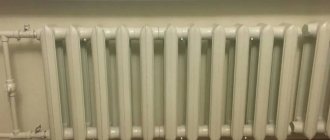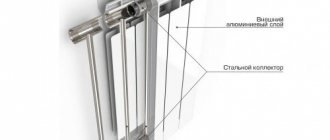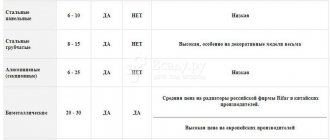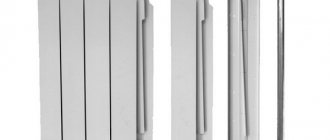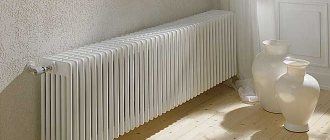Bimetallic batteries today occupy one of the leading places in popularity. They are inferior in this position, probably, only to the usual cast-iron radiators, and even then, most likely, only due to the extreme prevalence of the latter, the adherence of many consumers to established traditions, and a kind of “inertia of thinking.”
Bimetallic heating radiators rating of manufacturers
Bimetallic radiators are increasingly being chosen for installation in the heating circuit of both a private house and a city apartment, since they, unlike aluminum and steel, have a pronounced resistance to increased pressure loads and temperatures. However, when choosing these heating devices, it is very important not to run into low-quality fakes or purchase products from a manufacturer that has not yet passed the test of time. Therefore, let's consider the question formulated in this way: “bimetallic heating radiators rating of manufacturers” - since this selection criterion plays far from a secondary role.
It is very difficult to give an accurate assessment of all bimetallic radiators on sale. Therefore, the publication will consider only a few companies, but they have already gained indisputable authority with the quality of their products.
Bimetallic radiator: device and types
The new generation heating device is made of aluminum and steel. The most important thing about it is its internal structure.
Radiators are divided into two types:
- Full bimetallic, consisting of vertical tubes and horizontal steel collectors. The connected parts are die-cast aluminum. The advantage of this device is that the coolants are located so that you cannot get burned on them. Radiators can withstand high temperatures (up to 130 degrees) and pressure from 35 atmospheres. The number of elements can be removed or added from the battery.
- Partially bimetallic, having only a steel vertical channel that conducts water. Such batteries are not protected from rust, but they do not have excess pressure. Such models are most often found on the Russian market.
Some manufacturers offer bimetallic radiators made of copper and aluminum. These are universal models, but the price for bimetallic heating radiators of this type is much higher.
The aluminum body has a built-in copper coil that can withstand 40 atmospheres of pressure. The advantage of such a battery is that copper conducts heat well and does not rust.
Pros and cons of bimetallic radiators
In Russia, bimetallic batteries are just beginning to be in demand, but in Europe such radiators have been used for more than ten years.
Batteries made of aluminum and steel have a number of advantages over their cast iron counterparts:
- The device is resistant to high water pressure, which makes it possible to install it in apartment buildings;
- Good thermal output, which allows you to get about 170 Watts of heat from one section;
- Withstands temperatures above 100 degrees;
- Does not rust, so the battery can be used for a long time;
- If you install a temperature regulator on the radiator, you can control the heat in the room;
- Modern design and compactness;
- Service life up to 30 years.
Reviews of bimetallic heating radiators are not always positive. Many consider the disadvantages of bimetallic radiators to be:
- High cost;
- There should be no air in the coolant;
- Low permeability of pipes causes deposits to appear.
There are few disadvantages; they do not stand out so much against the background of positive properties.
Conclusion
The presented models are among the six best bimetallic heating batteries for the 2020/2021 heating season. These devices are in great demand among our customers. We hope this information was useful to you.
– a specialized heating equipment store. Many years of experience and positive customer feedback allow us to guarantee high quality service and qualified specialist assistance at all stages of the transaction: from the necessary calculations to installation assistance.
Choose a reliable and high-quality heating radiator at a reasonable cost on progreem.by.
Main characteristics
If we focus on European models, we can identify a number of the best bimetallic heating radiators, based on their qualities.
- Heat release. It is necessary to know this, since the area of the premises varies and small radiators will not cope with their heating. When an apartment or house has ceilings lower than three meters and good thermal insulation, the thermal power is calculated per 10 square meters of 1 kilowatt of power. If the question arises about connecting bimetallic heating radiators, then it is better to choose, for example, 2 of 5 sections than one with 10 sections. Several heat sources will create more efficient heating of the room.
- The pressure is selected based on where the batteries will be installed. For a home with pressure control, a 10 atmosphere radiator will be sufficient. In high-rise buildings you will have to buy a high-pressure radiator (25-35 atm). Manufacturers often indicate measurements in Pascals, but remember that 10 atmospheres equals 1 mPa.
- The connection in each home is designed individually. You should think in advance about what kind of connection you will have. Since there are three types: diagonal, bottom and side.
- Length between battery input and output collectors. According to the standard, the center distance should be 35 and 50 centimeters. Manufacturers supply the market with an assortment of these sizes, so it will not be difficult to choose the right option.
What else is worth paying attention to
Before purchasing a Teplomir radiator, you should definitely read reviews about it. As for the described model, consumers respond positively to it. For example, the test pressure is quite high and is 24 atmospheres. The center distance is 500 mm. It is also important to pay attention to the working pressure, it is 16 atmospheres.
Consumers are also interested in the volume, it reaches 3.2 liters. The connection is made from the side. A mounting kit is not supplied with the battery. This cast product comes with a 17-year manufacturer's warranty.
Choosing a good bimetallic radiator
The Russian market offers a certified range of heating batteries, differing not only in countries of manufacture and companies.
There are also certain points that are important when purchasing:
- When choosing a radiator, you should be careful not to buy a pseudo-battery. Only the vertically standing columns are made of steel, and the rest of the elements are made of aluminum. These models are inferior in quality to bimetallic radiators;
- It is better not to choose a product from a Chinese manufacturer, because the technical characteristics written in the passport differ in practice. After installing such a heating element, breakdowns may occur or the house will be cold;
- A high-quality bimetal radiator has copper and steel inserts as thick as the wall of a water pipe;
- You should check the coating of all elements for chips and scratches;
- Often sellers offer a cheaper version of aluminum batteries, which do not differ in appearance from bimetallic ones. These models differ in weight, since there are no light radiators.
Which bimetallic heating radiators are better is determined by many parameters, and price plays a big role here. The buyer first pays attention to the cost of the product, and then to the quality.
Budget radiators are supplied to the market by manufacturers from China and Russia. They offer a section within four hundred rubles. In such models the pressure is lower, the design is simplified and material is saved during manufacturing.
Radiators from the Italian companies Zira and Global, as well as the Russian brand RIFAR, have proven themselves to be good. Developers offer customers elements equipped with a thermostat or air vent and various mounting methods.
Bimetallic radiators, which are of high quality, are best purchased in specialized stores. Consultants will help you make your choice and calculate the number of required sections for the room. Typically, such stores provide delivery of goods.
Determining the number of bimetal sections
Calculating the required number of sections and correctly determining which bimetallic radiators are best makes it possible to create comfortable living conditions. The calculation is performed using a simple formula, for which it is enough to know the area of the heated room and the power of one section. The second parameter is always indicated by the manufacturer in the device passport; you can also find out the power of one section from the store’s price list.
To achieve maximum effect when heating a room, it is enough to use thermal energy in the amount of 100 W per 1 m2. Based on this, the number of sections of bimetallic radiators is calculated using the formula:
N=S*100/P,
Where N is the required number of sections,
S – room area,
P – power of one section.
For example, you need to determine the number of sections of a bimetallic radiator installed in a room with an area of 20 m2, knowing that the power of one section is 160 W. Substituting the indicated values into the well-known formula, the following is obtained:
20*100/160=12,5.
Consequently, 13 sections are sufficient to effectively heat the specified room.
However, it should be borne in mind that using the specified formula to determine the number of sections may not give an accurate result. To do this, it is necessary to take into account many other factors that can affect the amount of thermal energy required. For example, heating a room with two external walls requires more heat than one with one external wall. A correction factor helps solve the problem in this situation. To calculate the number of sections of a bimetallic radiator in a corner room, a coefficient of 1.2 is used. For a room with two external walls, the calculation will be as follows:
13*1,2=15,6.
That is, 16 sections will be required.
The amount of heat for comfortable living largely depends on the following factors:
- Climatic conditions of the area.
- Predominant wind direction.
- Location of external walls.
- The quality of thermal insulation of the entire house.
- Number of door and window openings.
- Radiator installation location.
In addition, there are many other factors that determine the required amount of heat for a particular room.
